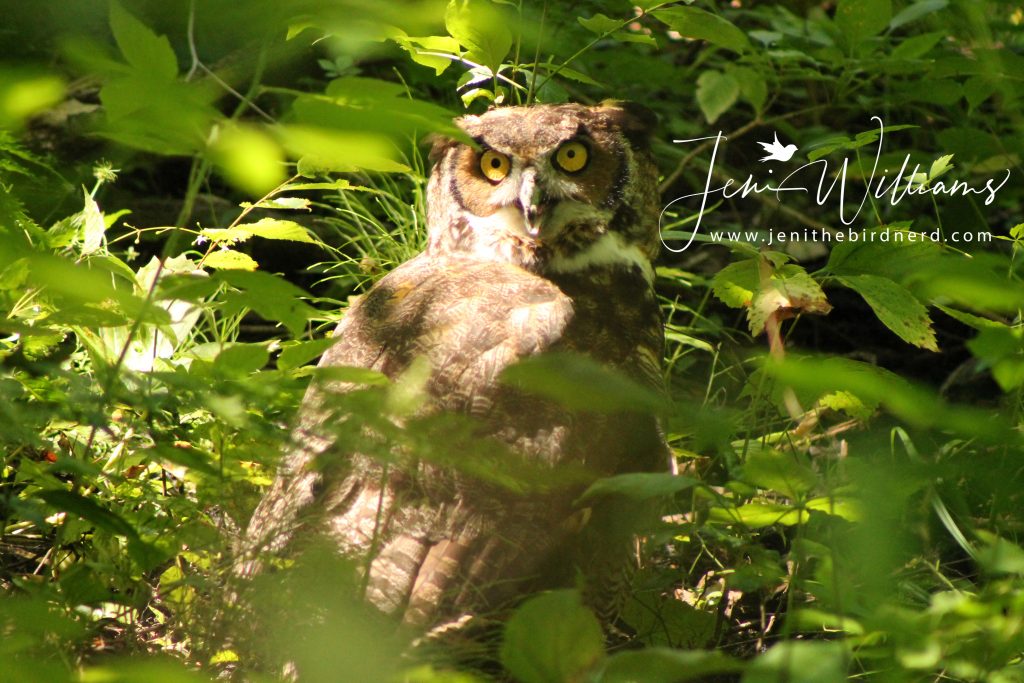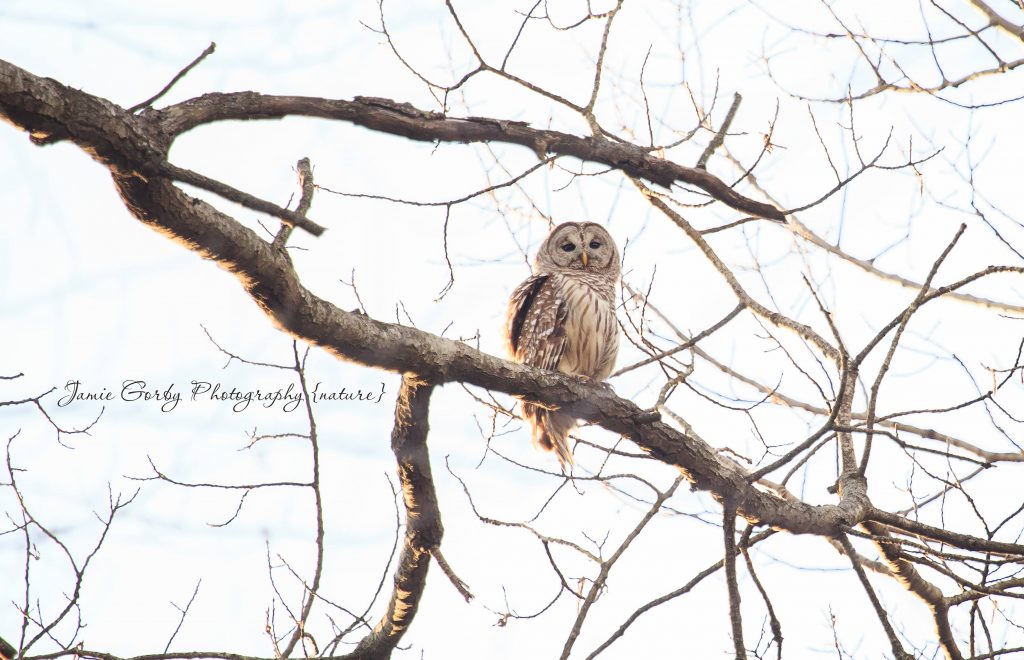It’s no secret that owls are my one of my favorite birds, woodpeckers rank right up there in my book, too. Quite often people tell me they heard an owl but they weren’t sure what kind it was and they’d like help identifying what they’ve heard. In mid-Michigan it’s likely to be a Great Horned, Barred or Screech owl. I’ll tell a little about each of them in the following paragraphs.
The Great-horned owl is the most common and largest owl, found in our area. They are 18-24″ in length, thick birds with two feathered tufts on their heads and large yellow eyes. Their bodies are a mottled gray-brown with a reddish brown face and white patch on their throat. A fun fact, their eyes don’t move in their sockets, instead this owl can move it’s head more than 180 degrees to look in any direction. GHO’s are nocturnal and will feed on small animals such as squirrels, other birds, rabbits, mice and frogs to name a few. GHO’s do not migrate and can be found year-round in Michigan.
Great Horned owls are monogamous and begin nesting in late January and will often take over nests built by other birds, most commonly hawks and crows. The female will lay a clutch of 1-4 eggs and incubate them for 30-37 days; her mate will bring her food while she sits.
Click here to hear Great Horned own sounds. You’ll need to scroll down to the middle of the page to click on the play button.
The owl pictured below is named Stanton. She ran into the side of a vehicle one evening in 2014 and was injured to where she needed desperate medical attention. She spent almost a year at Michigan State University receiving care and when she was healed and able to be released, MSU contacted the Deputy that brought her in. He picked her up and brought her back to the same area in which she was originally found and released her. I was fortunate enough to be able to participate in her release.
The next largest owl found in our area is the Barred owl. This is a medium sized owl, 16-19″ in length, their feathers are mottled brown and white with brown eyes. Their breasts are white with brown horizontal stripes, while their body and wings are brown with barred white stripes, kind of like a Barred Rock chicken. Like GHO’s, Barred owls eat small animals.
The Barred owl call is very easily identified by the “Who cooks for you? Who cooks for you-all?” call. You can listen to it by clicking here. You’ll need to scroll down to the middle of the page and click the play button.
It isn’t known for sure but it is suspected that Barred owls mate for life. The female will lay a clutch of 1-5 eggs anywhere from the end of March to late April and will incubate the eggs for 28-33 days. Barred owls typically nest in cavities of trees, adopt other bird’s nest and they will also inhabit nest boxes. If you’re interested in trying to lure a Barred owl to your property, you can find plans for building a nesting box, here.
Barred Owls do not migrate and can be found in Michigan year-round. I read that of 158 owls that were banded and later found, none of them moved more than 6 miles from where they were originally banded. Barred owls are pretty tolerant of people and have been known to nest in backyards. It’s not uncommon to see any of these owls during the day roosting in a tree catching some z’s before another busy night of hunting.
I haven’t had the opportunity of photographing a Barred owl buy my friend and very talented photographer, Jamie Gorby, has. Jamie has a special power for finding owls; it seems like whenever she’s out in the woods she posts a picture of her find. Honestly, I’m a little jealous of her abilities. She has graciously let me use one of her pictures of a Barred owl that she encountered. Please check out her Facebook Page, Jamie Gorby Photography to see all of the beautiful pictures she’s taken. This girl has some talent!
The last and smallest owl that you are likely to encounter is the Eastern Screech owl. This cute, little guy is quite small, only about 6-9″ with yellow eyes. Screech owls can either be gray or a brownish red color; they tend to blend in quite well when perched in trees.
Screech owls tend to hunt at dark and eat small animals and other birds, some as big as Blue Jays! They can be found in wooded areas, parks and neighborhoods and are known for using nesting boxes. Screech owls are typically monogamous and will mate for life. The female will lay a clutch of 2-6 eggs, anywhere from late March to mid-May, and will incubate the eggs for 27-34 days. The male will hunt for her and bring her and the owlets food.
Screech owls have a different kind of call to them; it almost sounds like a horse whinny. To hear their call, click here. You’ll need to scroll down to the middle of the page and click the play button.
Mr. Bird Nerd and I built a Screech owl nesting box last spring and so far we had a pair of Cowbirds raise their young in it; it’s not exactly what I had in mind so the nest was removed and we’ll try again. I’ve read that it can take several years to get a pair to decide they want to raise their young in your nesting box. If you’re interested in building a box, click here for plans. Last year during spring cleanup, members of the MCC Nature Trails committee cleaned out several Wood Duck boxes and found evidence of Screech owls, even finding an owl taking a nap in the box.
Below is a picture of a Screech owl that I took in November of 2016. My friend Jamie, mentioned above, called me and told me that she had one that was frequenting a tree that had a hole in it in her woods and that it was there one afternoon. Naturally I took her up on her offer and went and photographed it.
I know this has been a long post but hopefully it will help you identify which owl you’ve heard. Don’t forget Saturday is the Owls and Mythology outing at MCC. I’ve added the event to the event calendar. I have heard all three of these owls while out hiking on the nature trails and have even went out at night trying to call for them. In previous outings, they have been successful in calling to a Barred owl. Unfortunately, I won’t be able to attend this outing as I have a prior commitment.
You can learn more about all of these owls by visiting The Cornell Lab of Ornithology.



